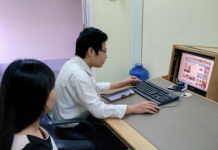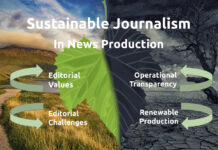The power balance shift to a superuser audience
![<a href="https://commons.wikimedia.org/wiki/File:Julien_Legraal.jpg" target="_new">Image by Rawpixels<>/a> released via <a href="https://commons.wikimedia.org" target="_blank">CC[0] Wikimedia Commons</a>](https://mediahelpingmedia.org/wp-content/uploads/2012/03/typewriter.jpg)
To survive, media organisations must create a clear editorial differential and embrace changing audience behaviour.
So how is mainstream media coping?
Some have done well to adapt to their new role, others are struggling to keep up.
Media organisations must harness social media for newsgathering and news dissemination, and create fact factories to deliver content to every device their audience turns to for information.
By doing so they could free up resources in order to focus on producing quality, original journalism. If they don’t they could suffer.
The power and control is now in the hands of the audience
- Technology has empowered the audience to the point where they are now users rather than consumers.
- Now they have choice, and turn to peer groups and trusted networks for news recommendations.
- Content has to be available in the format the audience demands, otherwise it has less chance of being used.
- Broadcasters and publishers no longer control the process, the audience does.
The audience is now the superuser
- When publishing and broadcasting was just about print, TV and radio, we, the publishers and broadcasters, were the superusers.
- Technology and social media tools have made the audience the superuser.
- The audience is reworking content, enhancing it, making it more relevant for their peers.
- We must watch and respond to changing audience behaviour to remain relevant.
Multiplatform is essential, not an option
- We need to be on whatever device users turn to for their information.
- If we are absent from a platform, we will not reach its audience.
- We need to develop workflows and technical processes that enable us to exploit each platform to best effect.
A shot in the arm for journalism
- Technological advances and changing audience behaviour are liberating for journalism.
- It means we can return to what we do best, which is producing quality content and establishing a unique editorial voice.
- A way of doing this is to create fact factories delivering to multiple platforms.
The news production line
Journalism is about uncovering facts and delivering them to the audience.
Along the way we check, verify, attribute, prioritise and add background information to support those facts.
Then we present them. It’s a fairly simple production line logic; gather material, process it and then offer it to the customer.
In many ways it’s similar to most production lines.
News organisations are essentially fact factories; each trying to come up with a production formula and quality of product that best matches the needs of their target audience.
In doing so they are trying to establish a differential that secures a viable presence in the market.
The broadcast at model
Before the internet and digital – when it was just about newspaper publishing and broadcasting – the models were fairly straightforward.
We, the media, published and broadcast at the audience.
We did our market research, and we created products we thought would sell, but there was no audience engagement – unless you count carefully selected letters to the editors and heavily produced talk shows.
The engage with on our terms model
Gradually we allowed the audience to be part of the process, but only on our terms.
We would publish letters to the editor, invite participants to take part in live TV and radio shows, and encourage people to comment on our online forums.
But we would select the topics for discussion and we would publish or air only those comments that fitted our editorial thrust.
The participate model
Digital and online media changed all that in a number of ways:
- more outlets appeared competing for the attention of the audience.
- more devices were produced through which the audience could consume news and information.
- more opportunities to engage with news and the people in the news became available.
- the audience turned to peer group recommendation.
- readers and viewers were empowered by free tools with which they could publish and broadcast.
Caught off-guard by the speed of change
What media organisations failed to grasp at first – and it’s understandable because things changed so fast – was that news had to be delivered to the audience on whatever device they turned to, not just on the main legacy platform – be it print or broadcast.
The industry tried its best to respond as new devices/platforms appeared.
Publishers and broadcasters created websites and produced mobile and digital versions of their content to try to keep up.
Much of it, at first, was a copy-paste version of the main product, sometimes produced off-site, in some cases by a different team working away from the main newsroom.
It was a brave effort, although it was fraught with problems, many of which were down to a lack of an editorial strategy.
Embracing convergence
In 1997, I was one of the editors asked to set up and launch BBC News Online.
To get the site up and running we had to find a newsroom, hire staff and fight to get hold of any content from our broadcast colleagues.
We were seen as a poor relation and a bit of a distraction to many; some also clearly saw us as competition.
The broadcasters were on the first floor at BBC Television Centre in London. We were on the seventh.
They guarded their content in order to protect their scheduled programmes. We wanted to publish the news as it happened and update it day and night, 24 hours a day and seven days a week.
Two years later I was hired to be the launch managing editor for CNN.com Europe Middle East and Africa (EMEA).
It was the first international English-language version of CNN to be produced outside America.
At first the plan was that we would build our own newsroom and create a new global site with an EMEA focus. But because of space restriction we had to occupy a different floor to our broadcast colleagues, but in terms of co-operation around news, the attitude couldn’t have been more different.
We put all our efforts into convergence. We shared news meetings, prospects, staff and technical resources.
Because of that I was able to introduce a system of publishing called multiplatform authoring (MPA), where content created once by one journalist could go out in an instant on multiple revenue-generating platforms.
At one stage we were serving 10 such platforms from our online stories at the press of the save button.
A few years later, as an editorial and strategy consultant for the launch of Al Jazeera English, we were working with one converged newsroom based around a centralised command-and-control superdesk where all the main news decisions were made.
However, even then it was a fight to get the TV team to see the importance of having a web duty editor sitting in the main newsroom. The online material was prepared in another room on another floor.
Amazing how much has changed over such a short period.
Leapfrogging legacy problems
For the last 10 years I have been advising on the creation of converged newsrooms for both print and broadcast media organisations worldwide, setting up converged newsrooms in Africa, the Middle East, the Caucasus and Asia.
Things continue to move at a rapid pace. A big driver has been the growth of mobile and the decline in the use of so-called traditional mainstream media.
What also seems apparent is that media houses outside the heavily-developed Western media scene are often far more agile and able to adapt and evolve without all the table-thumping and kicking and screaming that can take place where legacy workflows, roles and responsibilities, empires and influence are entrenched and threatened.
I have introduced converged newsrooms in Tbilisi, Hanoi and Harare simply by moving a few chairs and desks and setting up a central superdesk.
Sometimes it’s involved knocking down a few partition walls and creating a space where everyone can breathe the same news air and hear the same news calls.
In all cases it’s been important to help media managers and journalists understand that if they share and work together they can create a more dynamic, compelling and user-focused product than if they fight for the status quo.
Of course it helps when there is total buy-in from the top where those in charge realise that convergence is a business essential not a disruptive distraction.
A change of thinking is needed
The time has come for publishers to forget they are publishers and for broadcasters to forget they are broadcasters.
Those of us who are in the business of producing news need to ensure that we are delivering content to whatever device the audience is turning to in order to access information.
If there is a platform where we don’t have a presence we are missing an opportunity and probably missing an audience.
If our production priorities, workflows, roles and responsibilities and resources are all focused on one platform only we may be not only limiting our news organisation’s growth but also losing audience and revenue.
And if we deliver to a new platform we need to ensure that we improve and enrich our content to make it rewarding.
We are asking the audience to give us its time – a precious resource – and the audience will come back only if that experience is the best they can get in the time they have available and on the device they use.
How we respond to these digital demands will determine whether we will survive as a media business. The good news is that it can be done, is being done, and it isn’t as hard as it sounds.








